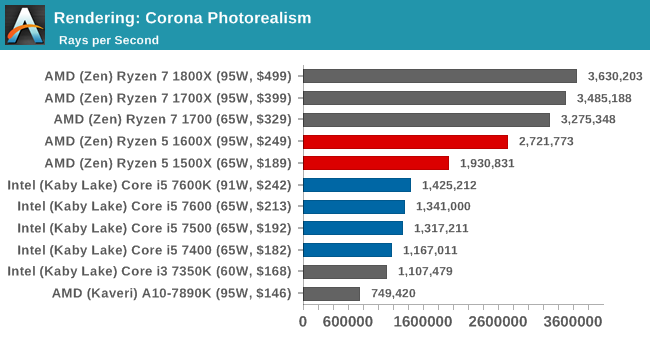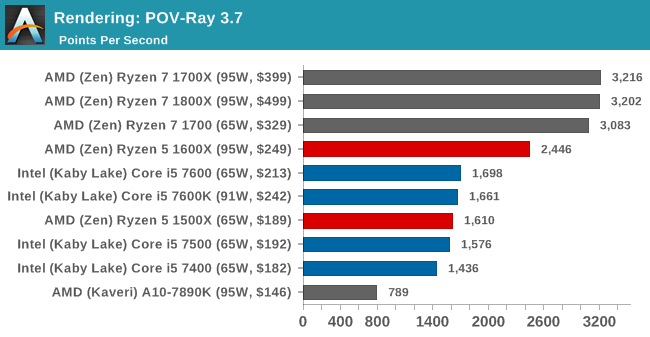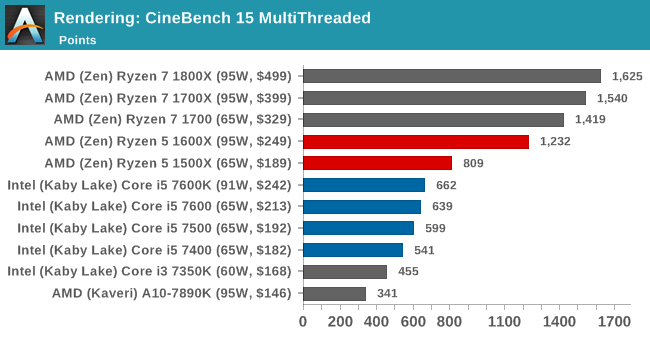The AMD Ryzen 5 1600X vs Core i5 Review: Twelve Threads vs Four at $250
by Ian Cutress on April 11, 2017 9:00 AM ESTBenchmarking Performance: CPU Rendering Tests
Rendering tests are a long-time favorite of reviewers and benchmarkers, as the code used by rendering packages is usually highly optimized to squeeze every little bit of performance out. Sometimes rendering programs end up being heavily memory dependent as well - when you have that many threads flying about with a ton of data, having low latency memory can be key to everything. Here we take a few of the usual rendering packages under Windows 10, as well as a few new interesting benchmarks.
Corona 1.3
Corona is a standalone package designed to assist software like 3ds Max and Maya with photorealism via ray tracing. It's simple - shoot rays, get pixels. OK, it's more complicated than that, but the benchmark renders a fixed scene six times and offers results in terms of time and rays per second. The official benchmark tables list user submitted results in terms of time, however I feel rays per second is a better metric (in general, scores where higher is better seem to be easier to explain anyway). Corona likes to pile on the threads, so the results end up being very staggered based on thread count.
Blender 2.78
For a render that has been around for what seems like ages, Blender is still a highly popular tool. We managed to wrap up a standard workload into the February 5 nightly build of Blender and measure the time it takes to render the first frame of the scene. Being one of the bigger open source tools out there, it means both AMD and Intel work actively to help improve the codebase, for better or for worse on their own/each other's microarchitecture.
POV-Ray 3.7.1
Another regular benchmark in most suites, POV-Ray is another ray-tracer but has been around for many years. It just so happens that during the run up to AMD's Ryzen launch, the code base started to get active again with developers making changes to the code and pushing out updates. Our version and benchmarking started just before that was happening, but given time we will see where the POV-Ray code ends up and adjust in due course.
Cinebench R15
The latest version of CineBench has also become one of those 'used everywhere' benchmarks, particularly as an indicator of single thread performance. High IPC and high frequency gives performance in ST, whereas having good scaling and many cores is where the MT test wins out.















254 Comments
View All Comments
marecki - Tuesday, April 11, 2017 - link
PDF OpeningCan you link this PDF file?
Ratman6161 - Tuesday, April 11, 2017 - link
Hmmm. Food for thought. So I've been sticking with my trusty old i72600K. I use VMWAre workstation to run VM's on my desktop quite a lot. I've always figured a lot of threads were helpful so that VM's and the host OS aren't competing for resources. But the VM's themselves aren't doing anything particularly intense. When not running VM's probably any old i5 level of performance is probably good enough. So...for my particular purposes seems like the Ryzen 5 1600X might be the way to go and save a bunch of money while I'm at it???More than adequate for my desktop needs and more cores/threads than an i7 when running VM's...and way cheaper. First CPU I've seen tht's got me kind of tempted.
cheshirster - Tuesday, April 11, 2017 - link
That's where 1700 might look better.IanHagen - Tuesday, April 11, 2017 - link
I too am a heavy virtualization user and I'd say pick the 1700 if you can. More physical and logical cores are going to make a big difference for you.Ratman6161 - Tuesday, April 11, 2017 - link
I'm actually kind of looking for cheap. The Ryzen 5 1600x is more cores and threads than my trusty old i7-2600K and the 1600x is $140 less than the 1700. I'm actually considering going even cheaper and getting the 1600 instead of the 1600x. The main difference between the 1600 and 1600x seems to be clock speed and...they are unlocked so why not save $30 more and get the 1600?Ratman6161 - Tuesday, April 11, 2017 - link
PS: I'm thinking on going cheap with the CPU and using some of the savings on more RAM.psychobriggsy - Wednesday, April 12, 2017 - link
1600 comes with a cooler, 1600X doesn't, so bear that in mind during price comparisons.IanHagen - Tuesday, April 11, 2017 - link
Then I'd say get the 1600 and overclock it (:lakedude - Thursday, April 13, 2017 - link
Ryzen is not offering much in the way of OC headroom. Sure the chips are unlocked but they are already pushing them pretty hard, unlike the Cel300A from back in the day...Ratman6161 - Thursday, April 13, 2017 - link
True, the OC headroom doesn't seem that great. But for anyone willing to do a mild overclock (which I am) it seems like a no-brainer to choose the 1600 over the 1600x. The only difference seems to be clock speed other than the cooler (which I probably wouldn't use) and I'm betting that even pushing it a bit, the two would end up at the same maximum speed.